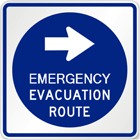
CSUSB's Building Evacuation Team (i.e. Building and Floor Marshals Program) was developed in order to enhance the overall emergency preparedness program throughout the campus. This program consists of dedicated Building and Floor Marshals assigned for each campus building to facilitate drills/exercises, preparedness activities, emergency communications, emergency plans, evacuations, disaster response, and recovery operations for their respective building.
The Building Evacuation Team (B.E.T.) program is designed to provide for the safe and rapid evacuation of CSUSB buildings in the event of an emergency. The teams are organized at two levels: Building Marshals and Floor Marshals. The Building Marshals and Floor Marshals facilitate the safe evacuation of their assigned building as dictated by the circumstances. They also work with their evacuation team members within their building to maintain their respective building's Emergency Action Plan (EAP), conduct training when necessary, and coordinate evacuation exercises within their respective buildings.
CSUSB's Building and Floor Marshals are dedicated CSUSB staff and faculty members serving the campus community to better prepare the campus for any emergency. Building Marshals are provided emergency kits/"Go Bags" with essential equipment and supplies to better assist them in these important emergency roles. In addition, Building Marshals have been provided with radios which allow them to communicate more effectively with the campus Emergency Operations Center, Office of Emergency Management, University Police, and Facilities Services.
Training is periodically provided to campus Building and Floor Marshals, relevant to their role and responsibility. Types of trainings provided include: CPR, first aid, evacuation chair operations, Standardized Emergency Management System (SEMS), National Incident Management System (NIMS), conducting situation assessments and damage assessments, handling active shooter situations, and radio communications.